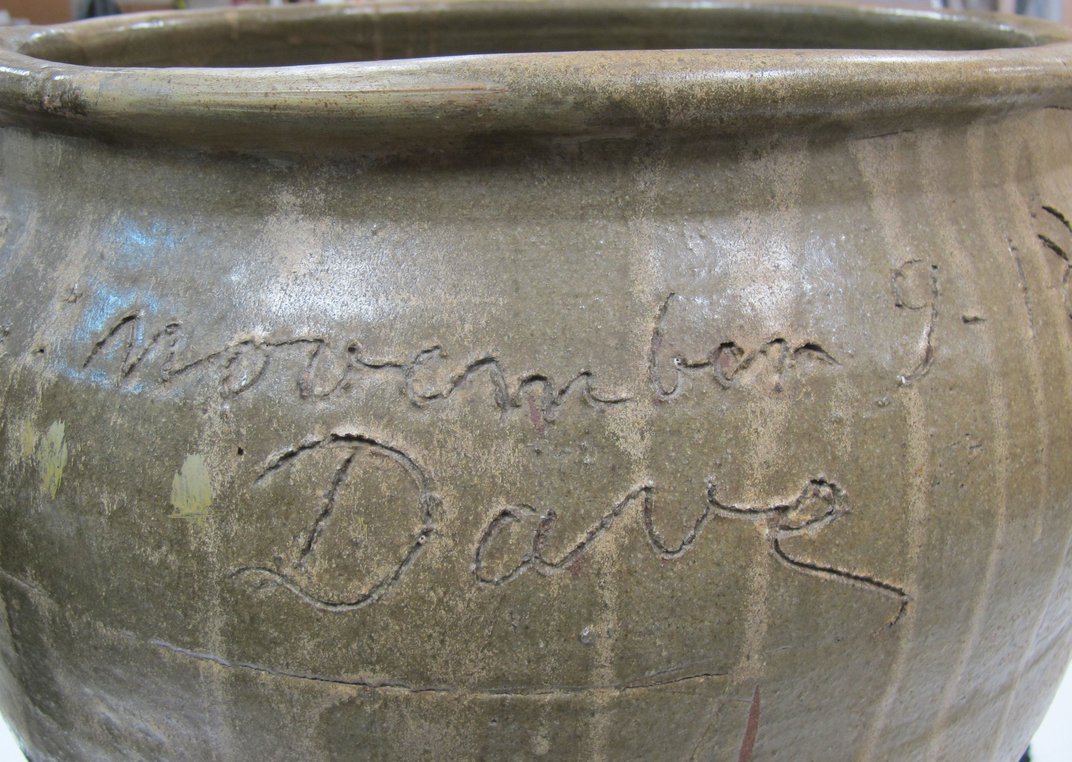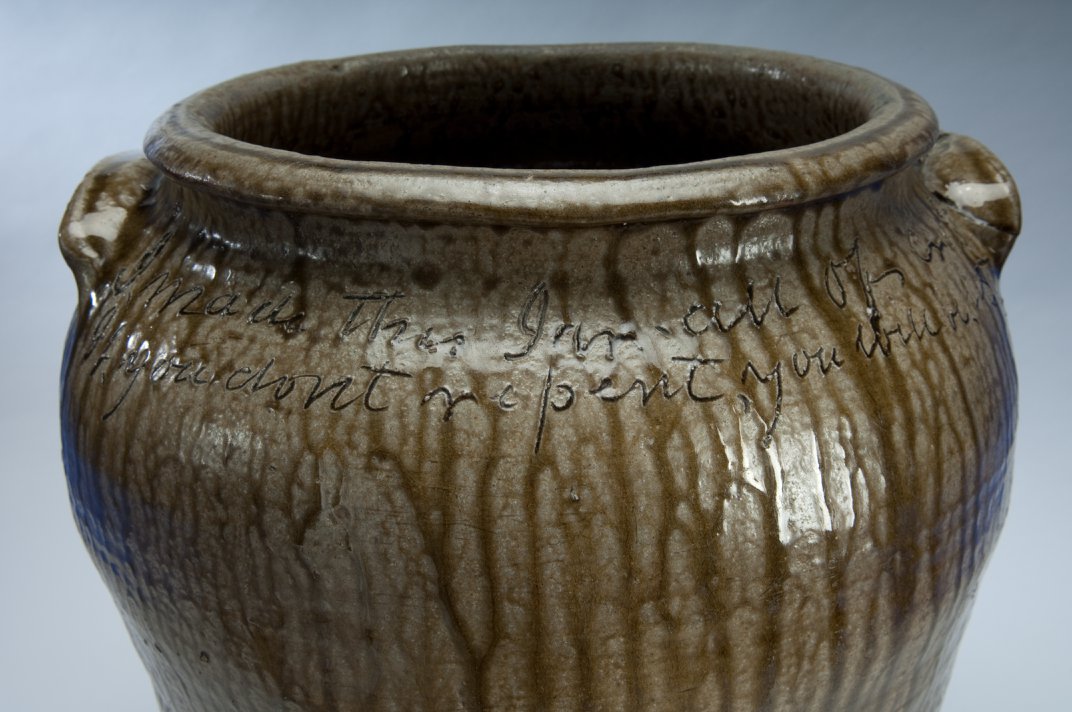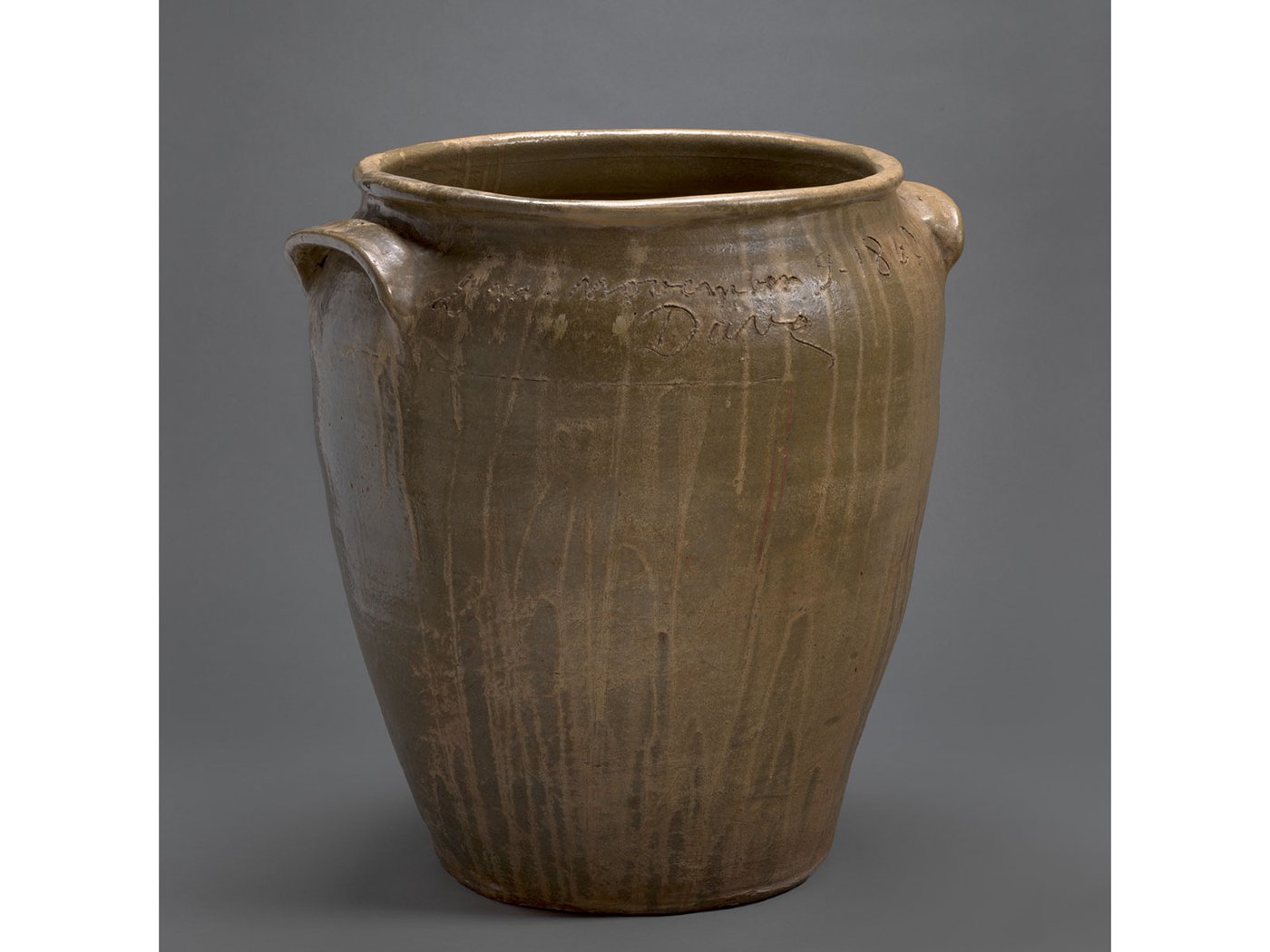The nearly two-foot-tall pottery vessel bears the date November 9, 1860; it was made by David Drake. Inscribed on the stoneware are Drake’s signature "Dave" and a couplet he wrote: “A noble jar, for pork or beef / then carry it around to the Indian chief.”
While various other 19th-century potters similarly inscribed their vessels, Drake’s rhyme stands out because the artist was born into slavery around the turn of the 19th century and labored in South Carolina, where an 1834 state law made it unlawful for the enslaved to learn to read and write.
The vessel arrived at the Smithsonian American Art Museum (SAAM) in 2021, a gift from the philanthropists Ann and Tom Cousins, and it is now on view on the museum’s second floor where the unwary visitor, seeing the brown-green jar elegantly encased in glass, might confuse it as a work of contemporary art.
A 2006 survey by the scholars Arthur F. Goldberg and James Witkowski counted 169 vessels made by and attributed to Drake. More than a hundred, dated between 1849 and 1864, are boldly signed "Dave." The size of the vessels varies from jugs to churns, and 18 of them were 19 inches or taller and could hold more than 15 gallons. Drake was only one of 76 known enslaved people who worked at the 12 potteries in Edgefield, South Carolina. His poetry and insignia are known to appear on 50 vessels, which were used as containers for food items. The one on view at the museum was probably used to preserve and store meat.
Craft as agency



Drake is one of the few enslaved people who had any agency as an artist or personally. Maker’s marks are often written or stamped on wares to identify the potter. But scholars have found no other jars from the Edgefield region inscribed in this way. His poetic musings and the use of his signature is a coded rebuke and a resistance to the inhumane laws of enslavement, says Leslie Umberger, SAAM’s curator of folk and self-taught art.
“Drake had a job to make utilitarian vessels of a certain type, but what he made far exceeded the form,” she says. “He created more than a mere jar to hold something; he made a record of himself, his artistry, his literacy, and of the state of things in his world as they were for his people.”
Although there were free Black artists who practiced painting in European traditions in the United States during the 19th century, including Joshua Johnson and Robert S. Duncanson, there were many more artisans creating pottery, clothing, sculpture and quilts who went unrecognized but are regarded today as highly valued artists. And, like Drake’s, their works are now exhibited in some of the nation’s most celebrated museums, from SAAM to the National Gallery of Art in Washington, D.C. to the Charleston Museum in South Carolina. The acclaimed show "Hear Me Now: The Black Potters of Old Edgefield, South Carolina," originating at the Metropolitan Museum of Art and featuring some of Drake's vessels, opens this month at the Museum of Fine Arts Boston before traveling on to Ann Arbor, Michigan, and Atlanta, Georgia.
“Few enslaved people in this country would have had the choice to pursue work as artists, and many free Black Americans faced significant challenges to becoming artists, including a lack of opportunities for artistic training and exclusion from spaces where their work could be exhibited,” says Jill Vaum Rothschild, who is the Luce Foundation curatorial fellow at SAAM.
“He created more than a mere jar to hold something; he made a record of himself, his artistry, his literacy, and of the state of things in his world as they were for his people.”
David Drake's life
Drake was born sometime around 1801. A record dated June 13, 1818, identifies “a boy about 17 years old, country born.” According to this documentation, Eldrid Simkins mortgaged him to Harvey Drake. He became a free man with the January 1, 1863, Emancipation Proclamation, and after the Civil War, he took the surname Drake from one of his enslavers. It’s believed that he died during the 1870s, because his name does not appear in the 1880 census. Beyond that, the record offers only a few details of his life that, while bare, convey the magnitude of what he endured: the sale away of his family and a leg amputation.
There are suggestions, according to scholar Jill Beute Koverman, that Drake may have received some payment for his work, as records from 1860 show ten men received $200 a month and four women were paid $41 a month. But there is no firm evidence that Drake was among them, because the records do not specify which of the workers were paid.
Some have speculated that Drake learned to read the Bible from one of his enslavers, Abner Landrum, who was a religious man. Others suggest he learned from working as a typesetter at the Edgefield Hive newspaper. The speculation yields no definitive answers.
Drake’s vessels were made in traditional English shapes that were European-influenced. Potters in Western Europe were generally men, while in Africa, women were potters. There are similarities in the pottery made by the female Catawba Indian potters of South Carolina, the Inca potters of Central and South America and the female potters of African and male potters of Asia, Koverman pointed out. Drake used a coiling method found in African and Native American methods. He also used the European wheel-throwing method.
“I noticed right away that there were these very pronounced ridges on the interior," says Ariel O’Connor, the Smithsonian conservator who examined, cleaned and prepared the vessel for display. "The outside is entirely smooth. But the bottom third has beautiful, even, pronounced ridges. There are 12 of them. At the middle it changes to a wider, smoother ridge on the inside. This suggested to me the bottom part was thrown on a wheel and then the top part was coil-built. It’s combining two techniques.”
To confirm this hypothesis, O'Connor X-rayed the vessel. “One of the great things that we saw on the X-ray was between the wheel-thrown part and the coil-built part, you can see thumbprints at a 45-degree angle. These are his fingerprints adding the first large coil onto the lower section that was thrown on the wheel,” O’Connor says. This process is physically strenuous, she points out, making Drake’s output as a man in his 60s all the more impressive.

The lyrical verses he used vary from the whimsical, “This noble jar will hold 20 / fill it with silver then you’ll have plenty,” to the religious, “I made this jar all of cross, / If you don’t repent, you will be lost,” to the intriguing: “Dave belongs to Mr Miles / Wher the oven bakes & the pot biles.”
Theaster Gates, a multimedia artist, urban planner and ceramicist, highlighted the connections between his work and Drake’s in the 2010 exhibition “To Speculate Darkly” at the Milwaukee Art Museum. Although Drake’s couplets were often comedic, Gates’ writing sought to capture the anger that was and is undoubtedly present in the lives of the enslaved and in their descendants. The exhibition featured a Drake jar surrounded by Gates’ art, including a Japanese-style ink painting of a similar vessel with the message: “Bitch, I made this pot.”
For many Black contemporary artists, including Phoenix Savage, a multidisciplinary artist who works across mediums including photography, cast iron and bronze, Drake is a figure who represents liberation and rebellion.
“Here is an enslaved person having had multiple owners, a leg amputation, the loss of his immediate family due to their sale as property, and we know him. He made sure of that.”
“Based upon the rules of the system of slavery, at no point should we have ever known of Dave the Potter. Yet we do,” says Savage. She cites Drake’s “inner agency” for his recognition. “Here is an enslaved person having had multiple owners, a leg amputation, the loss of his immediate family due to their sale as property, and we know him. He made sure of that.”
Drake’s position as an enslaved potter, Savage points out, allows us to understand human agency during enslavement. “As an artist, when I am conceiving of works, I ask myself, what will the work’s evidence of knowing inform someone in the future? Dave and his works are my touch point for such an understanding and re-invoking.”
“Artworks like Drake’s shine a light on the deep and abiding flaws of this fraught social structure, challenging assumptions from top to bottom, not just about literacy as a tool of the powerful and empowered,” adds Umberger, “but about the infinite possibilities of learning beyond conventional systems; about intelligence, intentionality, perseverance and achievement; and about creating an historical legacy for yourself without one bit of it being handed to you.”
On one of Drake’s vessels, dated August 16, 1857, the inscription reads a heart-wrenching, “I wonder where is all my relations / Friendship to all—and every nation.” Drake was an enslaved person who, although he exerted some amount of agency in his abilities, yearned for lost family.
Though Drake worked for Miles, the proprietor of Stoney Bluff Manufactory, during the Civil War, no vessels have been found that were signed or dated by him after the end of slavery in 1863. It’s remarkable that an enslaved person was able to create art in this period, even more so that he was able to express himself in writing.
“The inscriptions reveal not just a potter, but a poet,” Umberger says. “Not just a poet, but a radical witness and voice. Not just a protester, but a man with the intellectual savvy to walk a thin line between what boundaries he—as a plantation asset—could push, how he could say enough that neither he nor his work would be destroyed, and that his messages could make it out into his community and survive into the future.”


